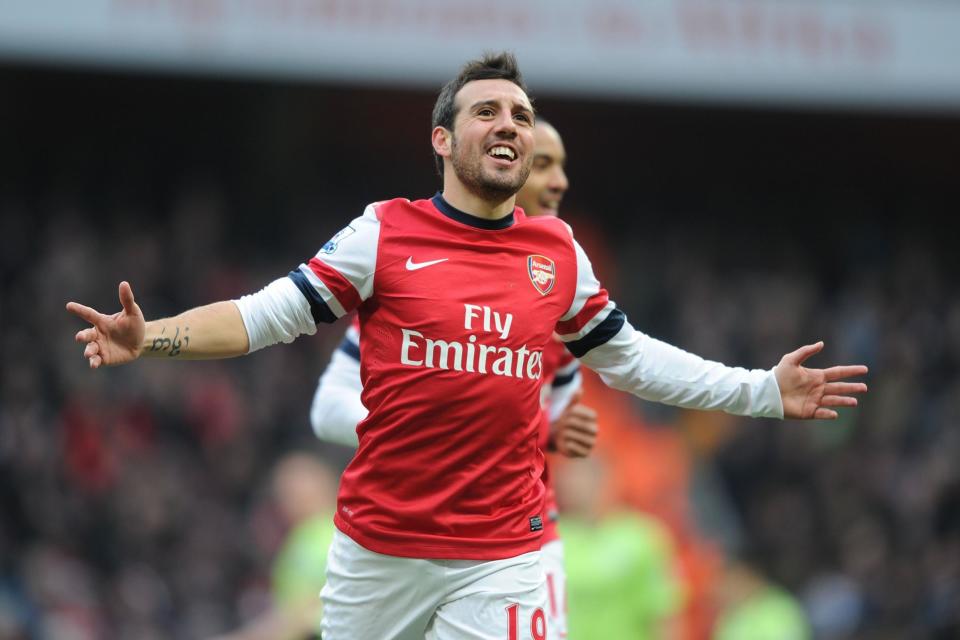Santi Cazorla's quality could have altered course of Arsenal's history... now his exit gives new boss first major test

It is a truth that no-one needs reminding of around the Emirates, but with Santi Cazorla in the side on a consistent basis the last few years would surely have gone much more swimmingly.
Indeed there is a convincing argument that had their beguiling playmaker been consistently available, Arsenal could have won the Premier League silverware that eluded Arsene Wenger in his final years.
Though his return to first-team training last month was warmly welcomed around Arsenal the sad truth is that the club simply could not justify extending his contract. Over 18 months on the sidelines and 11 Achilles and ankle operations mean that anyone who decides to offer Cazorla a playing contract is taking an unprecedented gamble.
His former club Villarreal are prepared to offer him a place to train during preseason and their head coach Javi Calleja hinted at the weekend they may even look to hand him a playing contract.
It is not a risk that Arsenal, who hope to have Jack Wilshere and Aaron Ramsey in their squad next season, are prepared to take. Memories of Abou Diaby, whose unquestionable potential meant Arsenal persevered with him perhaps longer than they should have, have not faded.
Not offering Cazorla a new contract is surely the right decision from Arsenal but it means the Spaniard departs as the great ‘what if?’ of Wenger’s final years. Would his presence have been enough to put together a convincing title challenge? Might the Frenchman still be in charge had he had his diminutive dynamo in the side?
The numbers prove that Arsenal were a different side with Cazorla at their heart. In the 2015-16 and 2016-17 seasons their Premier League win rate with him was 65 per cent. Without him Wenger’s side won just 49 per cent of games.
Wins | Draws | Losses | Win rate | Wins | Draws | Losses | Win rate | |
With Cazorla | 9 | 3 | 3 | 60% | 6 | 1 | 1 | 75% |
Without Cazorla | 11 | 8 | 4 | 48% | 15 | 5 | 8 | 50% |
It was in the former of those two campaigns that Cazorla’s absence was so keenly felt, and when his presence might just have pushed Arsenal over the line in Wenger’s last real title challenge, even if they did eventually finish 10 points off Leicester.
In that season Arsenal won 60 per cent of their games with Cazorla (extrapolated across a season that makes for the same 23 wins Leicester claimed), 49 per cent without him. They probably would have won the game against Norwich where the Achilles first flared up and he ended the 1-1 draw “on one leg”.
Similarly it seems plausible that points against the likes of Stoke, Southampton and Swansea might not have been frittered away with such abandon had they been able to retain possession and slice through middling sides with greater ease.
With Cazorla in the side Arsenal played like a Wenger team. The pace of their play, typified in 3-0 eviscerations of Manchester United and Chelsea early in the 2015-16 and 2016-17 seasons, came from deep.
Cazorla’s ability to play the right pass swiftly allowed Mesut Ozil to perform at his best. The German would pick the ball up with space and runners ahead of him and security in behind.
Wenger said of Ozil in March 2017: “He suffered a lot from the loss of Santi Cazorla.
“Cazorla in deep midfield, can get out of pressure, gets the ball played through to a player who is higher up and then Ozil is a player who, with the timing of the pass, with the ball at the right moment, he can always do damage.”
Ozil is not the only one to have suffered in Cazorla’s absence, as Francis Coquelin can attest.
We’ll never know whether another 23 games of Cazorla in 2015-16 would have seen Arsenal spoil Leicester’s fairytale, nor whether Arsenal could have kept up the impressive run of form with which they began the following season.
We can, however, be reasonably confident that the calamities would have been fewer and further between. Arsenal did not concede three or more goals in any of the Premier League games where Cazorla was positioned at the base of midfield. Without him the team atrophied, lacking much semblance of an identity or even a consistent formation.
Cazorla’s departure is an acknowledgement that Arsenal must now solve the problem they have been postponing for much of the past 18 months. How do they replace a player who, David Silva aside, is without parallel in the Premier League? Jack Wilshere could do a passable impression but is more dribbler than distributer.
Arsenal’s interest in Nice’s deep-lying playmaker Jean-Michael Seri is instructive, but he finds Chelsea and Manchester City more alluring. That perhaps points to the reality of searching for someone to replace Cazorla: a player of the requisite quality is likely just not available to the Gunners.
In that case Wenger’s successor, likely Mikel Arteta, is going to have to do what the Frenchman so struggled with in his final years: finding an identity beyond the brilliance of Cazorla.

 Yahoo News
Yahoo News 